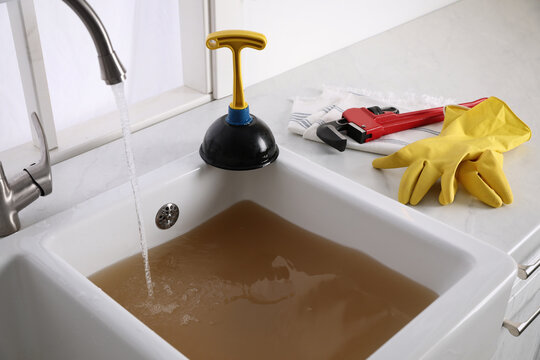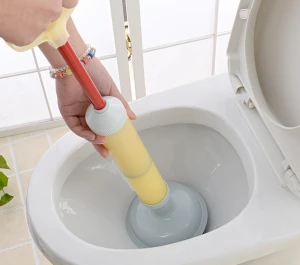What are your concepts on How to Use a Plunger to Unclog a Toilet or Drain?

Introduction
Correct upkeep of household drains is important for stopping blockages and making sure smooth water flow. One of the key tools in every home owner's toolkit is the bettor, along with different drain cleansers created to take on stubborn blockages effectively. This post explores how to make use of plungers and drain cleansers successfully to keep your drains pipes streaming easily.
Section 1: Comprehending Plungers
Sorts of Plungers
There are a number of kinds of bettors readily available, each designed for different sorts of drains and clogs. The most common kinds consist of mug bettors, flange plungers, and accordion bettors.
Just How Plungers Work
Plungers work on the principle of producing stress and suction to displace obstructions. When effectively used over a drainpipe, they develop a vacuum cleaner that can take out particles or separate obstructions.
Selecting the Right Plunger
Choosing the best plunger depends on the type of drain and the nature of the obstruction. Cup plungers are suitable for sinks and bathtubs, while flange plungers are better matched for toilets as a result of their design.
Usual Blunders with Plungers
Avoiding these mistakes guarantees efficient plunging: improper seal around the drain, not enough pressure, and not clearing bordering particles.
Area 2: Utilizing Plungers Efficiently
Prep work
Prior to diving, make certain the bettor covers the drain entirely and forms a limited seal. Clear any noticeable debris around the drainpipe opening.
Technique
Begin with mild diving movements to construct suction. Increase stress gradually, making use of a steady rhythm. Repeat as essential till the drain removes.
Troubleshooting Tips
If plunging does not function, try adjusting the seal, using oil jelly for a far better seal, or using a different kind of bettor.
Area 3: Understanding Drain Cleansers
Sorts Of Drainpipe Cleaning Company
Drain pipes cleansers can be chemical or enzymatic. Chemical cleansers make use of solid chemicals to liquify clogs, while enzymatic cleaners use natural enzymes to break down raw material.
How Drain Cleaning Company Job
Chemical cleansers react with clogs to liquify them, while enzymatic cleaners break down natural materials like hair and oil without damaging pipes.
Safety Factors to consider
Constantly wear gloves and eye defense when using chemical drain cleansers. Guarantee ample ventilation and comply with manufacturer instructions meticulously.
Eco-Friendly Alternatives
Think about using vinegar and cooking soda or enzyme-based cleansers for environment-friendly options that are more secure for pipes and the environment.
Area 4: Making Use Of Drain Cleaning Company Effectively
Application Strategies
Put chemical cleaners directly into the drain opening. Permit them to benefit the recommended time before flushing with hot water. Chemical cleansers must rest over night.
Preventative measures
Stay clear of blending various sorts of cleansers, as this can generate hazardous fumes. Never ever use chemical cleaners combined with a bettor, as spilling can happen.
Managing Persistent Clogs
For consistent obstructions, consider utilizing a pipes snake or calling a specialist plumbing to stop damages to pipes.
Final thought
Finally, understanding how to make use of bettors and drainpipe cleansers successfully is important for keeping healthy pipes systems. By choosing the right devices and techniques, homeowners can deal with small clogs and stop significant pipes issues down the line.
6 Common Drain Cleaning Mistakes and How to Avoid Them
Chemical Meltdown
When you have a blocked drain, one of the first solutions you may think of is to get chemicals to clear it. There are a lot of drain cleaning chemicals on the market and many make huge promises.
However, they often don’t live up to their promises. Depending on the kind of blockage you have, they may only worsen the problem and deepen your frustration.
If you have solids blocking a drain, it’s unlikely that chemicals will be able to clean it effectively. If the chemical is harsh but still cannot dissolve the blockage, then you are stuck with the blockage plus the chemicals inside the drain. Drain cleaning chemicals are toxic and can end up doing more harm than good.
Incorrect Plunging
One of the first drain cleaning tools you will probably reach for when you have a blockage is a plunger. There are several different plungers out there and they’re all made for separate kinds of drains. To get the job done, you need to choose the right plunger for the job.
Sink plungers will have a bell-shaped bottom. Toilet plungers, on the other hand, will have a flat bottom. However, even if you do have the right plunger, you need to make sure that you’re using it correctly.
Place it over the drain and completely seal it off. Push the plunger slowly and precisely, up and down. If you plunge too fast, you may push some of the matter that’s blocking the drain too far down.
Take your time when plunging. It’s understandable that you want to unblock the drain quickly, but plunging too fast can make matters worse.
Poking Into the Drain
After you’ve tried chemicals and even a plunger without much result, you may decide to get creative. But doing this while trying to unblock a drain can go badly.
For example, many people will try to dislodge the blockage by unbending a hanger and sticking it down the drain, but poking at the blockage is never a good idea.
Also, don’t try to use a stick to poke down the drain. It may break, leaving you with bigger problems. More often than not, once a plunger has failed to unblock the drain, poking something down may shove the matter causing the blockage to go further down the drain.
Sticking things down the drain can also put dents and holes into your drain pipe, which could leave you with a costly plumbing bill.
Garden Hosing
When you have a blocked drain outside, you may be tempted to grab your hose and start applying some pressure to try to unblock the drain.
Hydro jetting a blocked drain should be done with equipment that is designed for this purpose.
A garden hose is not the ideal equipment for trying to unblock a drain. The pressure from it will probably not be heavy enough to unblock the drain. This is especially true if the drain is outside and has been blocked by tree roots or even small animals.
Attempting to DIY hydro-jetting can cause flooding which will only make matters worse. It may also cause damage to the pipes.
Incorrect Use of a Drain Snake
A mechanical snake is a great way to unclog a drain. However, it should not be abused.
Do not force the drain snake around pipe corners that are hard to navigate. Using a drain snake too frequently and incorrectly can damage pipes leading to expensive repairs.
Avoiding the Plumber
DIY projects are to be celebrated. We understand that some homeowners would prefer to do repairs themselves to save some money . But there are certain instances where it’s just more cost-effective to call in a professional to deal with the problem.
If you’ve tried everything to unclog your drain and nothing is working, then there’s no need to go any further. It’s time to call a plumber!
https://trusteyman.com/blog/6-common-drain-cleaning-mistakes/

We were introduced to that report about How To Use Your Toilet Plunger Correctly in 5 Easy Steps through an acquaintance on a different blog. For those who enjoyed reading our article plz consider to pass it around. Thank you for your time invested reading it.
Click Here
Comments on “Using Plungers and Drain Cleaner: Effective Techniques”